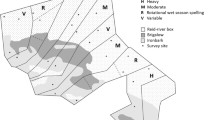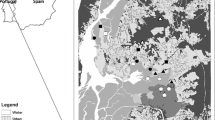Abstract
Few studies have examined how grazing intensity affects small Australian desert vertebrates, despite the large extent of the grazing industry and its potential effects on native biota. We examined small reptile, amphibian and mammal responses to two intensities (“grazed” and “less-grazed”) of cattle grazing in the stony plains system of arid South Australia. The study was undertaken during wet La Niña conditions when abundance of most species was expected to be highest. Total rainfall over the study period was over twice the mean yearly rainfall. Small vertebrates were sampled with pitfall and Elliott traps. Responses of individual species were compared among three grazed and three less-grazed sites. One agamid species (Ctenophorus gibba) was captured more frequently at grazed sites, and two skink species (Ctenotus olympicus and Menetia greyii) at less-grazed sites. Mus musculus (an exotic mammal) was caught most frequently at grazed sites. No native mammal species responded to grazing intensity. Low-moderate livestock grazing in this study system, during periods of high rainfall, did not have a negative effect on most species studied. Complementary studies should compare responses during drought.


Similar content being viewed by others
References
Adams M, Foster R, Hutchinson MN, Hutchinson RG, Donnellan SC (2003) The Australian Scincid lizard Menetia greyii: a new instance of widespread vertebrate parthenogenesis. Evolution 57:2619–2627
Asner GP, Elmore AJ, Olander LP, Martin RE, Harris AT (2004) Grazing systems, ecosystem responses, and global change. Annu Rev Env Resour 29:261–299
Beauvais GP, Buskirk SW (1999) Modifying estimates of sampling effort to account for sprung traps. Wildlife Soc B 27:39–43
Böhm M, Collen B, Baillie JEM, Bowles P, Chanson J, Cox N, Hammerson G et al (2013) The conservation status of the world’s reptiles. Biol Conserv 157:372–385
Brandle R (1998) A biological survey of the stony deserts, South Australia 1994–1997. Department for Environment, Heritage and Aboriginal Affairs, Adelaide
Brandle R, Moseby KE, Adams M (1999) The distribution, habitat requirements and conservation status of the plains rat, Pseudomys australis (Rodentia: Muridae). Wildlife Res 26:463–477
Burbidge AA, McKenzie NL (1989) Patterns in the modern decline of Western Australia’s vertebrate fauna: causes and conservation implications. Biol Conserv 50:143–198
Bureau of Meteorology (2012) Bureau of Meteorology. http://www.bom.gov.au/. Accessed 18 Nov 2012
Cole JR, Woinarski JCZ (2000) Rodents of the arid Northern Territory: conservation status and distribution. Wildlife Res 27:437–449
Dickman CR, Leung LK-P (2000) Status, ecological attributes and conservation status of native rodents in Queensland. Wildlife Res 27:333–346
Dickman CR, Predavec M, Downey FJ (1995) Long-range movements of small mammals in arid Australia: implications for land management. J Arid Environ 31:441–452
Dickman CR, Mahon PS, Masters P, Gibson DF (1999) Long-term dynamics of rodent populations in arid Australia: the influence of rainfall. Wildlife Res 26:389–403
Dickman CR, Lunney D, Matthews A (2000) Ecological attributes and conservation of native rodents in New South Wales. Wildlife Res 27:347–355
Dickman CR, Greenville AC, Tamayo B, Wardle GM (2011) Spatial dynamics of small mammals in central Australian desert habitats: the role of drought refugia. J Mammal 92:1193–1209
Drewry JJ (2006) Natural recovery of soil physical properties from treading damage of pastoral soils in New Zealand and Australia: a review. Agri Ecosys Environ 114:159–169
Evans DM, Redpath SM, Elston DA, Evans SA, Mitchell RJ, Dennis P (2006) To graze or not to graze? Sheep, voles, forestry and nature conservation in British uplands. J Appl Ecol 43:499–505
Fleischner TL (1994) Ecological costs of livestock grazing in western North America. Cons Biol 8:629–644
Flemming M (1998) European land use: domestic stocking in the stony desert. In: Brandle R (ed) A biological survey of the stony deserts, South Australia, 1994-1997. Heritage and Biodiversity Section, Department for Environment, Heritage and Aboriginal Affairs, Adelaide, pp 39–40
Frank ASK, Dickman CR, Wardle GM, Greenville AC (2013) Interactions of grazing history, cattle removal and time since rain drive divergent short-term responses by desert biota. PLoS One. doi:10.1371/journal.pone.0068466
Freeland WJ (1990) Large herbivorous mammals: exotic species in northern Australia. J Biogeo 17:445–449
Gee P (2000) A history of pastoralism in the Lake Eyre South drainage basin. Royal Geographical Society of South Australia Incorporated, Adelaide
Hagenah N, Prins HHT, Olff P (2009) Effects of large herbivores on murid rodents in a South African Savanna. J Tropic Ecol 25:483–492
James CD (2003) Response of vertebrates to fenceline contrasts in grazing intensity in semi-arid woodlands of eastern Australia. Austral Ecol 28:137–151
James CD, Landsberg J, Morton SR (1999) Provision of watering points in the Australian arid zone: a review of effects on biota. J Arid Environ 41:87–121
Keesing F (1998) Impacts of ungulates on the demography and diversity of small mammals in central Kenya. Oecologica 116:381–389
Kemper C, Reardon T, Queale L (2000) Mammals. In: Robinson AC, Hutchinson MN, Casperson KD (eds) A list of the vertebrates of South Australia. Department for Environment and Heritage, Adelaide
Landsberg J, James CD, Morton SR, Müller WJ, Stol J (2003) Abundance and composition of plant species along grazing gradients in Australian rangelands. J Appl Ecol 40:1008–1024
Lange R (1969) The piosphere: sheep track and dung patterns. J Range Manage 22:396–401
Letnic M, Dickman CR (2010) Resource pulses and mammalian dynamics: conceptual models for hummock grasslands and other Australian desert habitats. Biol Rev 85:501–521
Letnic M, Crowther MS, Koch F (2009) Does a top-predator provide an endangered rodent with refuge from an invasive mesopredator? Anim Conserv 12:302–312
McDonald PJ, Pavey CR, Fyfe G (2012) The lizard fauna of litter mats in the stony desert of the southern Northern Territory. Aust J Zool 60:166–172
Morton SR, Gillam MW, Jones KR, Fleming MR (1988) Relative efficiency of different pit-trap systems for sampling reptiles in spinifex grasslands. Aust Wildlife Res 15:571–577
Mott JJ, McComb AJ (1974) Patterns in annual vegetation and soil microrelief in an arid region of Western Australia. J Ecol 62:115–126
Nano CEM, Pavey CR (2013) Refining the ‘pulse-reserve’ model for arid central Australia: seasona rainfall, soil moisture and plant productivity in sand ridge and stony plains habitats of the Simpson Desert. Austral Ecol 38:741–753
Owens HM, Read JL (1999) Mammals of the Lake Eyre South region. Royal Geographical Society of South Australia Incorporated, Adelaide
Pavey CR, Nano CM (2013) Changes in richness and captures of rodents and native predators in response to extreme rainfall in arid Australia. Austral Ecol 38:777–785
Pavey CR, Eldridge SR, Heywood M (2008) Population dynamics and prey selection of native and introduced predators during a rodent outbreak in arid Australia. J Mammal 89:674–683
Pavey CR, Cole JF, McDonald PJ, Nano CEM (2014) Population dynamics and spatial ecology of a declining desert rodent, Pseudomys australis: the importance of refuges for persistence. J Mammal 95:615–625
Pestell AJL, Petit S (2007) Methods and ethical considerations of pitfall trapping for the western pygmy possum (Cercartetus concinnus Gould) (Marsupialia: Burramyidae), with observations on capture patterns and nest sites. Wildlife Res 34:296–305
Petit S, Waudby HP (2012) Standard Operating Procedures for aluminium box, wire cage, and pitfall trapping, handling, and temporary housing of small wild rodents and marsupials. Aust J Zool 60:392–401
Petit S, Waudby HP, Walker AT, Zanker R, Rau G (2012) A non-mutilating method for marking small wild mammals and reptiles. Aust J Zool 60:64–71
Read JL (1992) Influence of habitats, climate, grazing and mining on terrestrial vertebrates at Olympic Dam, South Australia. Range J 14:143–156
Read JL (2002) Experimental trial of Australian arid zone reptiles as early warning indicators of overgrazing by cattle. Austral Ecol 27:55–66
Read JL, Cunningham R (2010) Relative impacts of cattle grazing and feral animals on an Australian arid zone reptile and small mammal assemblage. Austral Ecol 35:314–324
Robinson AC, Kemper CM, Medlin GC, Watts CHS (2000) The rodents of South Australia. Wildlife Res 27:379–404
Rosenstock SS (1996) Shrub-grassland small mammal and revegetation responses to rest from grazing. J Range Manage 49:199–203
Smith GT, Arnold GW, Sarre S, Abensperg-Traun M, Steven DE (1996) The effect of habitat fragmentation and livestock grazing on animal communities in remnants of gimlet Eucalyptus salubris woodland in the Western Australian wheatbelt. II. Lizards. J Appl Ecol 33:1302–1310
Smyth AK, Brandle R, Chewings V, Read J, Brook A, Fleming M (2009) A framework for assessing regional biodiversity condition under changing environments of the arid Australian rangelands. Range J 31:87–101
Suominen O, Danell K (2006) Effects of large herbivores on other fauna. In: Danell K, Bergström R, Duncan P, Pastor J (eds) Large herbivore ecology, ecosystem dynamics and conservation. Cambridge University Press, Cambridge, pp 383–412
Tabeni S, Ojeda RA (2003) Assessing mammal responses to perturbations in temperature aridlands of Argentina. J Arid Environ 55:715–726
Taddese G, Mohamed Saleem MA, Ayalneh W (2002) Effect of livestock grazing on physical properties of a cracking and self-mulching vertisol. Aust J Exp Agri 42:129–133
Thompson SA, Thompson GG, Withers PC (2005) Influence of pit-trap type on the interpretation of fauna diversity. Wildlife Res 32:131–137
Wardle GM, Pavey CR, Dickman CR (2013) Greening of arid Australia: new insights from extreme years. Austral Ecol 38:731–740
Waudby HP (2013) Effects of cattle grazing on the biodiversity of cracking-clay gibber-gilgai systems in the arid South Australian rangelands. Ph.D. Thesis, University of South Australia, Adelaide
Waudby HP, Petit S (2011) Comments on the efficacy and use of visible implant elastomer (VIE) for marking lizards. South Aust Nat 85:7–13
Waudby HP, Petit S, Robinson G (2012) Pastoralists’ perceptions of biodiversity and land management strategies in the arid Stony Plains region of South Australia: implications for policy-makers. J Environ Manag 112:96–103
Waudby HP, Petit S, Robinsons G (2013a) Pastoralists’ knowledge of plant palatability and grazing indicators in an arid region of South Australia. Range J 35:445–454
Waudby HP, Petit S, Brown G (2013b) Use of creeks and gilgaied stony plains by cattle in arid rangelands during a wet summer: a case study with GPS/VHF radio collars. Range Manag Agrofor 34:101–107
Wilson S, Swan G (2010) A complete guide to reptiles of Australia. New Holland, Sydney
Woinarski JCZ, Ash AJ (2002) Responses of vertebrates to pastoralism, military land use and landscape position in an Australian tropical savanna. Austral Ecol 27:311–323
Woinarski JCZ, Fisher A (2003) Conservation and the maintenance of biodiversity in the rangelands. Range J 25:157–171
Woinarski JCZ, Burbidge AA, Harrison PL (2015) Ogoing unraveling of a contintenal fauna: decline and extinction of Australian mammals since European settlement. In: Proceedings of the National Academy of Sciences of the United States of America. doi:0.1073/pnas.1417301112
Acknowledgments
Sincere thanks to the Greenfield family of Billa Kalina for hosting us. Thank you also to our field assistants: Matt Gill, Ali Fairlamb, Hannah Spronk, Cam Forster, Jane Addison, Michael Heath, Kevin Lintern, Katie Ryan, Michael Jervois, Kim McArthur, Kath Hastie, Linda Rennie, Ashley Walker, and Tiffany Godfrey. We are grateful for the assistance of Mark Hutchinson, Cath Kemper, David Stemmer, and Graham Medlin from the South Australian Museum, and to Peggy Rismiller and Mike McKelvey of Pelican Lagoon Wildlife Research Centre. We are indebted to Rob Brandle who helped us locate our study site, and provided advice on working in the SPR. Chris Dickman and Gufu Oba kindly edited an earlier version of the manuscript. Two anonymous reviewers provided valuable comments. This research was funded by the Hermon Slade Foundation, the Holsworth Wildlife Research Endowment, the Nature Conservancy Applied Conservation Award and the Thomas Foundation, the South Australian chapter of the Australian Federation of University Women, the Nature Foundation of South Australia, the Australian Geographic Society, the Royal Geographical Society of South Australia, and the Wildlife Preservation Society of Australia. We acknowledge S. Kidman and Co. and the School of Natural and Built Environments at the University of South Australia for their support. This research was conducted under a National Parks and Wildlife Scientific Permit G25603 2, and ethics approval (72/08) from the Institute of Medical and Veterinary Science Animal Ethics Committee.
Author information
Authors and Affiliations
Corresponding author
Electronic supplementary material
Below is the link to the electronic supplementary material.
About this article
Cite this article
Waudby, H.P., Petit, S. Small Australian desert vertebrate responses to grazing intensity during La Niña. Ecol Res 30, 715–722 (2015). https://doi.org/10.1007/s11284-015-1274-2
Received:
Accepted:
Published:
Issue Date:
DOI: https://doi.org/10.1007/s11284-015-1274-2




